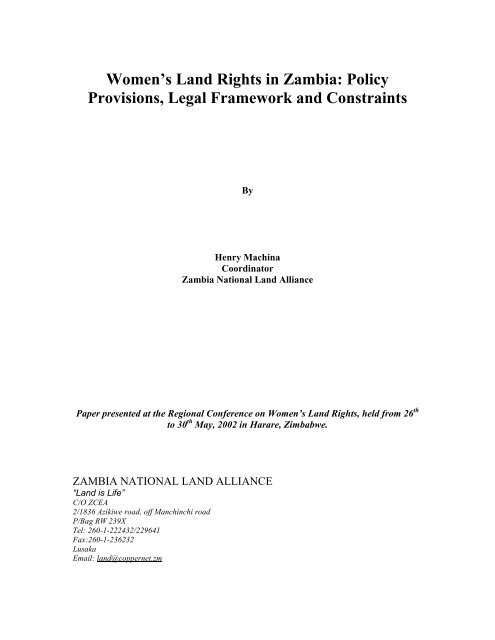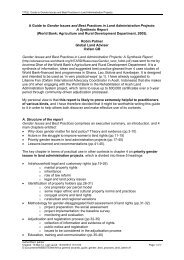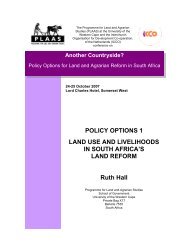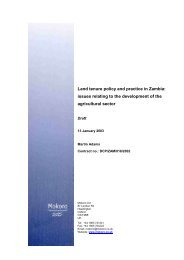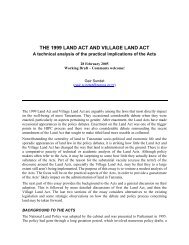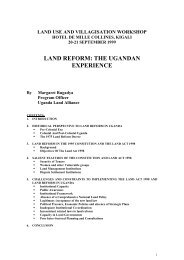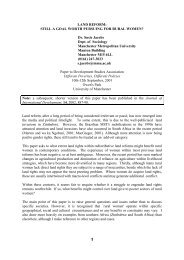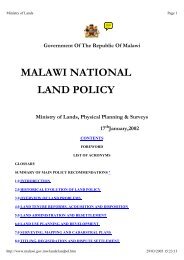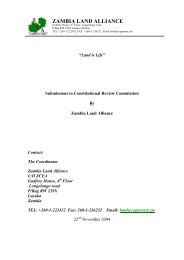Women's Land Rights in Zambia: Policy Provisions, Legal ... - Mokoro
Women's Land Rights in Zambia: Policy Provisions, Legal ... - Mokoro
Women's Land Rights in Zambia: Policy Provisions, Legal ... - Mokoro
You also want an ePaper? Increase the reach of your titles
YUMPU automatically turns print PDFs into web optimized ePapers that Google loves.
Women’s <strong>Land</strong> <strong>Rights</strong> <strong>in</strong> <strong>Zambia</strong>: <strong>Policy</strong><br />
<strong>Provisions</strong>, <strong>Legal</strong> Framework and Constra<strong>in</strong>ts<br />
By<br />
Henry Mach<strong>in</strong>a<br />
Coord<strong>in</strong>ator<br />
<strong>Zambia</strong> National <strong>Land</strong> Alliance<br />
Paper presented at the Regional Conference on Women’s <strong>Land</strong> <strong>Rights</strong>, held from 26 th<br />
to 30 th May, 2002 <strong>in</strong> Harare, Zimbabwe.<br />
ZAMBIA NATIONAL LAND ALLIANCE<br />
“<strong>Land</strong> is Life”<br />
C/O ZCEA<br />
2/1836 Azikiwe road, off Manch<strong>in</strong>chi road<br />
P/Bag RW 239X<br />
Tel: 260-1-222432/229641<br />
Fax:260-1-236232<br />
Lusaka<br />
Email: land@coppernet.zm
2<br />
Introduction<br />
To start my presentation, let me beg<strong>in</strong> by stat<strong>in</strong>g what our <strong>Zambia</strong>n Government has said<br />
over land and human life. In its current <strong>Land</strong> <strong>Policy</strong> document, the Government states<br />
thus:<br />
“<strong>Land</strong> is the biggest asset and forms the basis for all human survival <strong>in</strong><br />
terms of social and economic development” (GRZ, 2002).<br />
Fundamental as land may be to all humans, and despite be<strong>in</strong>g the majority among land<br />
users, women <strong>in</strong> <strong>Zambia</strong>, do not enjoy the same rights to land as men. Women are the<br />
produce most of the nation’s food, yet they are the majority among the poor. Women,<br />
particularly those voiceless ones based <strong>in</strong> remote rural areas are consistently left out <strong>in</strong><br />
legal and policy formulation processes, let alone <strong>in</strong> implementation, both historically and<br />
to the present. Women’s realization of land rights therefore, whether <strong>in</strong> rural or urban<br />
<strong>Zambia</strong>, is further hampered by male dom<strong>in</strong>ated patriarchal structures and mechanisms<br />
which, unfortunately, might take some substantial time to change. The current <strong>Zambia</strong>n<br />
land policy, laws and adm<strong>in</strong>istrative systems are yet to demonstrate their usefulness to the<br />
average woman.<br />
Out of the estimated 10,285,631 people <strong>in</strong> <strong>Zambia</strong>, 50.7% are female while 49.3% are<br />
male (GRZ, 2000). It is therefore clear that females are the majority <strong>in</strong> <strong>Zambia</strong>. As a<br />
result of men’s migration patterns over the years, women have been estimated to<br />
comprise about 65 per cent of the rural population (CSPR, 2001). Women, more than<br />
men necessarily provide the bulk of labour <strong>in</strong> subsistence agriculture and generate an<br />
estimated 70 per cent of the unpaid labour on small-scale farms. Women’s work also<br />
tends to be more cont<strong>in</strong>uous throughout the seasons, unlike that of men.<br />
Yet, despite this and the fact that most women’s livelihoods and that of their families<br />
depends on land, <strong>in</strong>secure land tenure and limited access to land cont<strong>in</strong>ues to characterize<br />
the legal relationship of most women. In <strong>Zambia</strong>, even <strong>in</strong> areas where women may<br />
access land, they are confronted with short-term problems of <strong>in</strong>put supply and animal<br />
traction (Smith, 2001). Women’s rights to land have been perpetuated by the social and<br />
traditional customs prevail<strong>in</strong>g <strong>in</strong> our society. Both the <strong>Zambia</strong>n Government and civil<br />
society have not taken adequate measures to ensure that women, who are part of our<br />
society, have adequate access and control over land.<br />
In this paper, we regard women’s rights to land from the view that women must access<br />
land for use at any time they want it. Access to land provides access to both <strong>in</strong>dividual<br />
and family socio-economic development. It is the most fundamental resource <strong>in</strong> any<br />
society and is the basis for survival for all human be<strong>in</strong>gs. <strong>Land</strong> also provides the safetynet<br />
for families <strong>in</strong> times of crisis; i.e. f<strong>in</strong>ancial or political. 1 From that po<strong>in</strong>t of view, we<br />
consider land as a right to women because land is the basis of life, and because “<strong>Land</strong> is<br />
Life”.<br />
1 Adapted from (Estermann, et al, 2002).
3<br />
Background to <strong>Land</strong> Tenure Arrangements <strong>in</strong> <strong>Zambia</strong><br />
Tenure is one of the pr<strong>in</strong>cipal factors determ<strong>in</strong><strong>in</strong>g the way <strong>in</strong> which resources are<br />
managed and used, and the manner <strong>in</strong> which the benefits are distributed (Rehoy, 1998.<br />
Cited <strong>in</strong> Mbaya and Ngaru, 2002). It is the way <strong>in</strong> which people hold, <strong>in</strong>dividually or<br />
collectively, rights to land. The control of the land and all or part of the natural resources<br />
upon it is described as the tenure system. S<strong>in</strong>ce colonial days, there have been three ma<strong>in</strong><br />
types of land tenure <strong>in</strong> <strong>Zambia</strong>. First, “reserve land” was set aside by colonialists for<br />
African residents, with communal rights adm<strong>in</strong>istered under customary law by the tribal<br />
chiefs. The system worked <strong>in</strong> accordance with dictates of patril<strong>in</strong>ial and or matril<strong>in</strong>eal<br />
tribe. These arrangements accounted for about 36 per cent of the country’s 752,000<br />
square kilometer land area. The land was jo<strong>in</strong>tly owned by all persons trac<strong>in</strong>g ancestry to<br />
a particular village. To ensure that <strong>Zambia</strong>ns (or Africans) did not lose their land to<br />
speculators, the law prohibited people from acquir<strong>in</strong>g certificates of title <strong>in</strong> native<br />
reserves. Second, “trust land” was also set aside for Africans but was settled under nontribal<br />
basis, with some land set aside for public purposes and with limited land grants<br />
available for non-Africans. This was also adm<strong>in</strong>istered by chiefs and comprised 58 per<br />
cent of all land. Third, about 6 per cent of the country was “state land”, adm<strong>in</strong>istered<br />
under English law, with freehold or leasehold titles (GRZ, 1996).<br />
It should be noted that <strong>Zambia</strong> was not a settler colony. The country was declared a<br />
Protectorate by the British Government <strong>in</strong> the early 1920s. One of the major<br />
characteristics of “Protectorate status” was that land was held <strong>in</strong> “trust” for <strong>Zambia</strong>ns.<br />
For this reason, much of <strong>Zambia</strong> did not experience ‘land grabb<strong>in</strong>g’ to the same extent as<br />
other countries <strong>in</strong> the Southern Africa region (Munalula, 1998).<br />
Dur<strong>in</strong>g the immediate post-colonial period, the United National Independence Party<br />
government implemented land reforms part of which <strong>in</strong> 1975 saw the vestment of land <strong>in</strong><br />
the President for and on behalf of the people. The President therefore reta<strong>in</strong>s the ultimate<br />
authority over land tenure arrangements.<br />
POLICY AND LEGAL REFORMS IN THE 1990S<br />
In 1991, there was a change of government, which saw the Movement for Multi-Party<br />
Democracy party take over power through a landslide electoral victory. The new<br />
government embarked on a massive economic liberalization programme. This <strong>in</strong>cluded<br />
change of land policy and law <strong>in</strong> l<strong>in</strong>e with the programme.<br />
<strong>Legal</strong> Framework<br />
The ma<strong>in</strong> land law <strong>in</strong> <strong>Zambia</strong> is the <strong>Land</strong>s Act of 1995. This law abolished the various<br />
categories of land and replaced them with only two namely:-<br />
a) State land, and<br />
b) Customary land
4<br />
It is important to note that the <strong>Land</strong>s Act itself <strong>in</strong> section 3 (6) leaves open the possibility<br />
of other categories. The President can give land <strong>in</strong> special circumstances to a person for<br />
any period exceed<strong>in</strong>g hundred years, which by implication is another way of preserv<strong>in</strong>g<br />
the freehold tenure and other categories of land not explicitly provided for <strong>in</strong> the Act.<br />
a) State <strong>Land</strong><br />
State land, as def<strong>in</strong>ed by the <strong>Land</strong>s Act of 1995, is that land which is not situated <strong>in</strong><br />
customary area. It is governed by English law and is said to cover about 6 per cent of the<br />
total land area <strong>in</strong> <strong>Zambia</strong>. 2 This consist of mostly land <strong>in</strong> urban areas along the l<strong>in</strong>e of<br />
rail rich <strong>in</strong> nutrients and m<strong>in</strong>eral deposits, and was tsetse-fly free dur<strong>in</strong>g colonial times.<br />
For one to obta<strong>in</strong> land <strong>in</strong> state land, one approaches local authorities that are supposed to<br />
advertise such land to the public. They then have to apply for the land and approach the<br />
Commissioner of <strong>Land</strong>s <strong>in</strong> the M<strong>in</strong>istry of <strong>Land</strong>s, act<strong>in</strong>g on behalf of the Republican<br />
President, for a title deed. A title is given after f<strong>in</strong>aliz<strong>in</strong>g documentation and necessary<br />
surveys are done.<br />
b) Customary <strong>Land</strong><br />
Customary land on the other hand is held under customs and traditions govern<strong>in</strong>g land<br />
use and ownership. These differ from place to place and are usually not written.<br />
However, there are common features <strong>in</strong> the various forms of customary tenure. To obta<strong>in</strong><br />
a title deed <strong>in</strong> customary areas, one identifies land through a village head or Chief. The<br />
identified land is sketched and endorsed by the Chief and accompanied by his/her hand<br />
written letter to the council <strong>in</strong> the area where the land is. The applicant then approaches<br />
the Commissioner of <strong>Land</strong>s for a title deed to the identified land.<br />
Strengths of the 1995 <strong>Land</strong>s Acts<br />
Some of the strengths of the Act are:<br />
To some extent, the Act limits the President's power to alienate customary land to<br />
consultation with the chief and local councils. This allows some limited<br />
democracy <strong>in</strong> alienat<strong>in</strong>g land.<br />
The Act provides for the conversion of customary land tenure to leasehold tenure.<br />
Whereas previously, no one could acquire title deeds (except under special<br />
provisions) <strong>in</strong> “customary areas”, today anyone can obta<strong>in</strong> a title deed from such<br />
areas provided they followed laid down procedures.<br />
2 In terms of size, customary land is still referred to be 94 per cent of all land <strong>in</strong> <strong>Zambia</strong> while state land is<br />
said to be 6 per cent. However, this is based on old estimates taken before the 1964 political <strong>in</strong>dependence.<br />
It could be much different if new measurements were taken today. More and more people have today been<br />
obta<strong>in</strong><strong>in</strong>g title deeds to customary land <strong>in</strong> addition to what is be<strong>in</strong>g granted to non-<strong>Zambia</strong>ns. The State has<br />
also been gett<strong>in</strong>g large chunks of land from customary areas for such purposes as state farms, rural<br />
reconstruction centres, resettlements, and other public purposes without land convert<strong>in</strong>g back to customary<br />
tenure (Hansungule, 2002).
5<br />
<br />
<br />
<br />
<br />
<br />
<br />
Controll<strong>in</strong>g settlements, methods of cultivation and utilisation of land <strong>in</strong> order to<br />
preserve natural resources.<br />
Provides for consent of the state for all land transactions.<br />
The Act also surrenders all council land to the Commissioner of <strong>Land</strong>s <strong>in</strong> the<br />
M<strong>in</strong>istry of <strong>Land</strong>s to allow for a standard system of land tenure to develop and to<br />
elim<strong>in</strong>ate discrim<strong>in</strong>atory systems of land hold<strong>in</strong>gs <strong>in</strong> councils.<br />
The <strong>Land</strong>s Act also allows for cont<strong>in</strong>uation of customary tenure and provides for<br />
approval of the chief for any conversion of rights from a customary tenure. This<br />
is good provided that the chiefs were democratic <strong>in</strong>stitutions who practiced their<br />
chiefly roles democratically.<br />
The Act establishes the <strong>Land</strong>s Development Fund <strong>in</strong> Section 8 (1), for the<br />
purposes of council authorities to improve land for allocation to land seekers.<br />
The Act establishes a <strong>Land</strong>s Tribunal to decide on all issues relat<strong>in</strong>g to land. This<br />
provision is good as long as the Tribunal is accessed by poor rural communities<br />
Civil Society’s Concerns about the <strong>Land</strong>s Act of 1995<br />
Despite the above strengths, the <strong>Land</strong>s Act has a number of weaknesses that civil society<br />
organisations are concerned about. Some of them <strong>in</strong>clude:<br />
Cont<strong>in</strong>u<strong>in</strong>g with vestment of all land absolutely <strong>in</strong> the President for and on behalf<br />
of the people of <strong>Zambia</strong>. This may open land adm<strong>in</strong>istration to abuse<br />
The mean<strong>in</strong>g of land which <strong>in</strong>cludes “any <strong>in</strong>terest <strong>in</strong> land whether the land is<br />
virg<strong>in</strong>, bare or has improvements,” but exclud<strong>in</strong>g any m<strong>in</strong><strong>in</strong>g rights as def<strong>in</strong>ed <strong>in</strong><br />
the M<strong>in</strong>es and M<strong>in</strong>erals Act, works aga<strong>in</strong>st the poor whose land is be<strong>in</strong>g used by<br />
small and large scale m<strong>in</strong>ers. That is, a m<strong>in</strong>er is not required to go through the<br />
Chief or local people before start<strong>in</strong>g to m<strong>in</strong>e <strong>in</strong> customary areas<br />
The <strong>Land</strong>s Act does not have enough safeguards to prevent abuse <strong>in</strong> land<br />
adm<strong>in</strong>istration. Numerous cases of abuse <strong>in</strong> land adm<strong>in</strong>istration have been<br />
reported on, among others, people obta<strong>in</strong><strong>in</strong>g title deeds to land <strong>in</strong> customary areas<br />
without consult<strong>in</strong>g chiefs and local councils. 3 In some cases, poor small - holder<br />
farmers have compla<strong>in</strong>ed that their traditional leaders and local bureaucrats are<br />
now allow<strong>in</strong>g <strong>Zambia</strong>s and foreign <strong>in</strong>vestors to buy the land where they and their<br />
ancestors have lived for generations (Keller, 2001).<br />
Section 8 – The approval of land applications by a chief for land conversion from<br />
customary tenure to a 99 year leasehold is not adequate <strong>in</strong> that it ignores people <strong>in</strong><br />
the area and the fact that <strong>in</strong> customary law, the chief does not actually own land.<br />
He/she simply holds it on behalf of the people<br />
In terms of implementation, the <strong>Land</strong> Development Fund, is usually <strong>in</strong>accessible<br />
by the councils and rural people<br />
3 See also the <strong>Zambia</strong>n Sunday Mail (27 th March 2002), the <strong>Zambia</strong> Daily Mail (1 st April 2002), the<br />
National Mirror (29 th Dec. – 4 th Jan 2002).
6<br />
<br />
<br />
<br />
Section 9 – Provision on illegal occupation of vacant land gives no option to those<br />
occupiers who have occupied the land throughout their lives and lives of ancestors<br />
even when land has been alienated without regard to the <strong>in</strong>terests of such people 4<br />
Section 22 – The jurisdiction of the Tribunal is too wide when not adequately<br />
funded to carry out its operations and as discussed later, the tribunal is<br />
<strong>in</strong>accessible to most poor people.<br />
Section 3(4a) of The <strong>Land</strong>s Act of 1995 states that The President shall not alienate<br />
any land situated <strong>in</strong> a district or an area where land is held under customary tenure<br />
“without tak<strong>in</strong>g <strong>in</strong>to consideration the local customary law on land tenure<br />
WHICH IS NOT IN CONFLICT WITH THIS ACT.” This means that the Act<br />
considers customary land tenure <strong>in</strong>ferior to modern or statutory tenure and<br />
therefore renders those hold<strong>in</strong>g land under customary tenure at risk of los<strong>in</strong>g land.<br />
Furthermore, <strong>in</strong> theory, the <strong>Land</strong>s Act does not discrim<strong>in</strong>ate aga<strong>in</strong>st women. Women <strong>in</strong><br />
<strong>Zambia</strong> can apply for any land <strong>in</strong> any part of the country, just like their male<br />
counterparts. The law however, ignores the long historical reality of an unequal society<br />
<strong>in</strong> which women have not had access, ownership and control over land. It assumes that<br />
there is gender equality <strong>in</strong> land. Hence the law has no gender sensitive framework under<br />
which this imbalance could be checked and corrected.<br />
Above all, the <strong>Land</strong>s Act of 1995 stems from the Government’s land reform programme<br />
embarked on <strong>in</strong> the early 1990s. The draft land policy then, and the draft <strong>Land</strong>s Act of<br />
1994, were not formulated <strong>in</strong> a participatory manner. Many stakeholders <strong>in</strong>clud<strong>in</strong>g<br />
traditional rulers, the church, rural communities and NGOs expressed resentment to these<br />
documents and called for their review. This however, could not yield much fruit as the<br />
Government and Parliament went ahead to enact the draft <strong>Land</strong>s Act <strong>in</strong>to law, while<br />
ignor<strong>in</strong>g the people’s concerns. It should be noted that the process of formulation of a<br />
piece of legislation is as important as the law itself. Therefore, despite some of its<br />
strengths listed above, <strong>Zambia</strong>’s <strong>Land</strong>s Act does not cater for the concerns of major<br />
stakeholders <strong>in</strong> land such as traditional rulers, the generally poor, the church community,<br />
the poor women, and therefore raises critical questions of ownership. It is a law of the<br />
rich who can afford to use it to their advantage.<br />
The poor, especially most rural women who cannot afford land adm<strong>in</strong>istration costs and<br />
legal costs <strong>in</strong> case of disputes, rema<strong>in</strong> not only at a disadvantaged but also at risk of<br />
los<strong>in</strong>g their land to the rich. Cases have been reported where wealthy people have<br />
acquired land along major rivers and have fenced it, leav<strong>in</strong>g villagers and their domestic<br />
animals deprived access to water resources. In other cases, the poor, voiceless people<br />
have been evicted from their land to pave way to the rich who have acquired such land<br />
through money oriented adm<strong>in</strong>istration system. For <strong>in</strong>stance, 15 families <strong>in</strong> Chongwe<br />
district of Lusaka Prov<strong>in</strong>ce of <strong>Zambia</strong> had their houses burnt after a court order was<br />
issued (see the <strong>Zambia</strong> Daily Mail, 27 th August 2001). In 1997, 89 families were bitten<br />
up by the police and court bailiffs, and evicted from the land which was formerly theirs<br />
because an <strong>in</strong>dividual had acquired title to about 2,000 hectares of land <strong>in</strong> Choma district<br />
4 For example, the squatters who are settled or have been farm<strong>in</strong>g on m<strong>in</strong>e land on the Copperbelt prov<strong>in</strong>ce<br />
of <strong>Zambia</strong>.
7<br />
of Southern Prov<strong>in</strong>ce. In these cases, women have tended to be the most disadvantaged.<br />
Lament<strong>in</strong>g her ordeal, one widow from Siachoobe village had this to say:<br />
“I was evicted from my village <strong>in</strong> Siachoobe, beaten by Court Bailiffs as if<br />
am a young person (She was 64 years old at the time of this <strong>in</strong>terview). Com<strong>in</strong>g<br />
here I was just given this small portion, which they said is 12 hectors. I am not<br />
sure whether this plot is actually 12 hectors. I do not know how to measure it.<br />
My son whom we were beaten together with was denied a plot here at Harmony.<br />
He is now married with two children and has no land of his own.”<br />
The widow cont<strong>in</strong>ued her narration say<strong>in</strong>g:<br />
“here we are squeezed and we have to share this small piece of land. Even our<br />
cattle have no enough land to graze from s<strong>in</strong>ce other people who do not want our<br />
cattle to graze from their plots surround us. Where will our children be <strong>in</strong> future<br />
From the time we were evicted from Siachoobe, hunger entered our home and it<br />
has never left. We cannot even grow enough food to feed our children because<br />
of not hav<strong>in</strong>g enough land,” she question amid anger. “Please do someth<strong>in</strong>g and<br />
help us. Besides, at least I have a portion of land. There are some people who<br />
were not given any plot and are now suffer<strong>in</strong>g because of what ibantu ba nguzu<br />
(powerful people) can do.”<br />
Another woman 8 children at the same settlement compla<strong>in</strong>ed of hav<strong>in</strong>g been<br />
discrim<strong>in</strong>ated aga<strong>in</strong>st <strong>in</strong> issuance of land at a resettlement area by the committee.<br />
“because my husband is a quiet person. I had to go to the resettlement office and<br />
demand that my family be given a plot. At last I was given this plot. But the plot<br />
is too small and swampy. Other people who did not even come from Siachoobe<br />
were given good and big plots. This is very unfair!” (NLA, 2001).<br />
<strong>Policy</strong> Framework<br />
The land policy <strong>in</strong>itiated <strong>in</strong> about 1993 is said to have been f<strong>in</strong>alised only <strong>in</strong> 2000. The<br />
<strong>Policy</strong> recognizes the need to <strong>in</strong>crease women’s access to land. It states that “while<br />
current laws do not discrim<strong>in</strong>ate aga<strong>in</strong>st women, women still lack security of tenure to<br />
land <strong>in</strong> comparison with their male counterparts.” The policy goes ahead to blame<br />
customary and traditional practices for the problem. The Government therefore commits<br />
itself to “redress the gender imbalances and other forms of discrim<strong>in</strong>ation <strong>in</strong> land hold<strong>in</strong>g<br />
by provid<strong>in</strong>g an enabl<strong>in</strong>g environment for women…..” (GRZ, 2002) The <strong>Policy</strong> also<br />
recognizes the important role that civil society <strong>in</strong>stitutions should play <strong>in</strong> land issues <strong>in</strong><br />
<strong>Zambia</strong>.<br />
However, although the policy mentions gender, it does not comprehensively address<br />
gender <strong>in</strong>equality <strong>in</strong> access to and ownership of land. For example, while there was a<br />
policy pronouncement <strong>in</strong> 1999 by the M<strong>in</strong>istry of <strong>Land</strong>s, to the effect that 10 per cent of<br />
all advertised plots of land should be given to women, the f<strong>in</strong>al policy document actually<br />
did away with that step of affirmative action by omitt<strong>in</strong>g the 10 per cent provision. This
8<br />
raises questions as to how serious our Government is <strong>in</strong> enabl<strong>in</strong>g women realise their<br />
land rights.<br />
Further, the land policy has a market orientation based on neo-liberal reason<strong>in</strong>g that land<br />
reform was more likely to result <strong>in</strong> poverty reduction if it was implemented <strong>in</strong> accordance<br />
with the operation of exist<strong>in</strong>g land markets. But while it may be necessary for poor<br />
people to acquire title deeds for their land, as emphasized by both the policy and the<br />
<strong>Land</strong>s Act, a title to a poor, voiceless, remotely based woman, may not necessarily be a<br />
means to access<strong>in</strong>g wealth. Possession of a title deed may not necessarily mean that one<br />
is go<strong>in</strong>g to use it. Therefore, this approach tends to marg<strong>in</strong>alize women, most of whom<br />
cannot access the markets because of lack of resources among other constra<strong>in</strong>ts.<br />
Sometimes, government policy encourages the dispossession of land from those who hold<br />
it under customary tenure <strong>in</strong> order to convert it to state leaseholds and thereby make it<br />
available for leas<strong>in</strong>g on the state market. Government policy believes that hold<strong>in</strong>g land<br />
under customary tenure is an <strong>in</strong>efficient way of own<strong>in</strong>g land and one that must be<br />
discouraged at all costs. This is why <strong>in</strong> both the law and policy on land tenure, there is<br />
no provision or mechanism for convert<strong>in</strong>g leasehold land back to customary tenure even<br />
when it is necessary. Accord<strong>in</strong>g to government policy implication, progress is marked<br />
through convert<strong>in</strong>g land from customary system to modern leasehold system. This<br />
ignores the fact that development may be achieved where land is held under customary<br />
tenure and that <strong>in</strong>security may not necessarily be a problem (see Smith, 2001).<br />
<strong>Land</strong>s Tribunal<br />
At this po<strong>in</strong>t, it is worth comment<strong>in</strong>g on the <strong>Land</strong>s Tribunal. The 1995 <strong>Land</strong>s Act<br />
establishes a <strong>Land</strong>s Tribunal. The idea was to f<strong>in</strong>d a cheaper and efficient means of<br />
settl<strong>in</strong>g disputes that arise <strong>in</strong> land. Courts are congested with workloads and it is very<br />
expensive to pursue cases <strong>in</strong> courts. Most people that generally face evictions are<br />
desperately poor to mobilise funds to hire lawyers to argue their cases for them. This is<br />
why Section 20 provided for the Tribunal (Hansungule, 2002).<br />
But the Act is discrim<strong>in</strong>atory of the poor, <strong>in</strong> a number of respects. It provides, for<br />
<strong>in</strong>stance, <strong>in</strong> Section 25, that a person may appear before the Tribunal either <strong>in</strong> person or<br />
"through a legal practitioner at his own expense". The right to legal representation <strong>in</strong> the<br />
constitution is a basic human right. Given that most disputes are between <strong>in</strong>dividuals and<br />
the State, it is very unfair for the Act to deny the <strong>in</strong>dividual the right to be represented<br />
before the Tribunal at the expense of the State.<br />
But even more, the idea of a Tribunal as a middle-course justice system has been<br />
destroyed by the Act itself. As po<strong>in</strong>ted out, the idea was to have a cheap, simple and<br />
efficient mechanism for the resolution of disputes. But <strong>in</strong> practice, the Tribunal has<br />
become even too technical to allow easy participation by lay persons, which was the<br />
orig<strong>in</strong>al <strong>in</strong>tention. Consequently, many people that have disputes feel <strong>in</strong>timidated to<br />
appear before the tribunal because it has become another court (Hansungule, 2001).
9<br />
Section 23 (5) provides that, "the Tribunal shall not be bound by the rules of evidence<br />
applied <strong>in</strong> civil matters". But the practice shows that the Tribunal Secretariat <strong>in</strong>sists on<br />
properly drawn forms and affidavits before the matter can be enterta<strong>in</strong>ed. This is a<br />
violation of the letter and spirit of the Act and constitutes discrim<strong>in</strong>ation aga<strong>in</strong>st the poor.<br />
Similarly, it is not clear how far the tribunal has reached the poor. When asked, the<br />
Registrar could not release such <strong>in</strong>formation, argu<strong>in</strong>g that “such <strong>in</strong>formation is not<br />
necessary for an assignment like yours.” It has however been stated elsewhere that the<br />
tribunal’s operations have been restricted to only major centres such as Lusaka and the<br />
Copperbelt. This discrim<strong>in</strong>ates aga<strong>in</strong>st rural people and makes the Tribunal an alien<br />
<strong>in</strong>stitution <strong>in</strong> the eyes of the poor, and women <strong>in</strong> particular.<br />
Furthermore, from the time the male dom<strong>in</strong>ated committee of the tribunal was established<br />
<strong>in</strong> 1996, it did not <strong>in</strong>volve traditional rulers, NGOs or religious representatives, even<br />
though the law provided a way for that. 5 And where <strong>in</strong>formation is such as cases dealt by<br />
the tribunal concerned, it is <strong>in</strong>formation difficult to access from the Secretariat. Statistics<br />
are not available for public use and are not gender disaggregated.<br />
WOMEN’S CONSTRAINTS IN CUSTOMARY LAND<br />
As already po<strong>in</strong>ted out, accord<strong>in</strong>g to the law, women enjoy the same rights <strong>in</strong> land as men<br />
under customary tenure. However, far few women than men hold land <strong>in</strong> their own right<br />
whether <strong>in</strong> rural or urban <strong>Zambia</strong>. This is due to traditional and cultural structures,<br />
patriarchal attitudes, 6 women’s submissive attitudes to male dom<strong>in</strong>ation, lack of<br />
knowledge on land rights and economic constra<strong>in</strong>ts (WLSA, 2001:29). In rural and<br />
urban areas, and whether educated or not, women do not have equal opportunity to<br />
access, <strong>in</strong>herit and buy land by comparison with men.<br />
Article 23 of <strong>Zambia</strong>’s Constitution of 1991, amended <strong>in</strong> 1996, forbids laws that<br />
discrim<strong>in</strong>ate on the basis of sex/gender. At the same time, however, the constitution<br />
explicitly excludes from this provision, personal law - such as that concern<strong>in</strong>g <strong>in</strong>heritance<br />
of property - and the application of customary law. In the past, customary law provided<br />
some safeguards to protect women’s access to (though not control over) land. However,<br />
these safeguards rarely operate today. As Bonnie Keller (2000) po<strong>in</strong>ts out, although there<br />
are ethnic differences <strong>in</strong> bodies of customary law and these have changed through time,<br />
an over-rid<strong>in</strong>g commonality is that women are treated as m<strong>in</strong>ors who are subord<strong>in</strong>ate to<br />
men - fathers, uncles, brothers and husbands.<br />
In rural areas, married women have access to land for farm<strong>in</strong>g through their husbands. In<br />
the event of divorce or widowhood, they may be permitted to cont<strong>in</strong>ue to use the land,<br />
but under customary law they will hardly <strong>in</strong>herit control of this land. Most divorce or<br />
5 A week ago, the M<strong>in</strong>ister of <strong>Land</strong>s announced the dissolution of the Committee of the <strong>Land</strong>s Tribunal<br />
partly because the committee had been <strong>in</strong> existence for six years <strong>in</strong>stead of the three years as legally<br />
mandated. The dissolution was necessitated by the need to make the tribunal more effective and<br />
representative of a wider majority of people (<strong>Zambia</strong> Daily Mail 20 th May 2002).<br />
6 Patriarchy is a system of social structures and practices <strong>in</strong> which men dom<strong>in</strong>ate women. This happens <strong>in</strong><br />
almost all spheres of life <strong>in</strong>clud<strong>in</strong>g law, commerce, education, political or village leadership, etc.
10<br />
widowed rural women return to their natal families, where they are dependent upon male<br />
k<strong>in</strong> for access to land. The local chief may allocate a plot to a s<strong>in</strong>gle woman, particularly<br />
if she has children, but it would be unth<strong>in</strong>kable to allocate a plot to a married woman <strong>in</strong><br />
her own right. Most rural women do not yet challenge their unequal positions under<br />
customary law. Female chiefs do not act differently from their male counterparts <strong>in</strong><br />
adm<strong>in</strong>ister<strong>in</strong>g land to the disadvantage of women.<br />
In those matrimonial societies such as parts of North-Western Prov<strong>in</strong>ce where marriages<br />
are generally uxorilocal, i.e. the husband moves to live at his wife's village, a woman may<br />
have had a small garden cleared for her by her relatives before marriage. After the<br />
marriage, the family of the wife would give the newly married couple more land to cater<br />
for her and her husband's needs. The husband then acquires only cont<strong>in</strong>gent rights for the<br />
duration of the uxorilocal marriage. In the event of divorce or death, of the husband, the<br />
widow will reta<strong>in</strong> the land or such part of it as she wishes.<br />
On the other hand, <strong>in</strong> virilocal marriages, i.e. where the wife moves to her husband's<br />
village, she will only have the use of her husband's land at the latter's pleasure and <strong>in</strong> the<br />
event of a divorce or husband's death, she will usually return to her own relatives. She<br />
acquires no rights of her own <strong>in</strong> her husband's land. In such a case, few women have<br />
fields cleared for them to hold <strong>in</strong> their own right. Widows however are regarded<br />
sympathetically. Often, they have land cleared for them by other men and over such land<br />
they can claim undisputed rights even though it is <strong>in</strong> the land of a deceased husband. This<br />
is particularly the case where the widow had children with the deceased spouse. Where a<br />
woman has been liv<strong>in</strong>g <strong>in</strong> a virilocal marriage and is widowed but chooses to cont<strong>in</strong>ue<br />
liv<strong>in</strong>g at the village of her late husband, she will normally be allowed to cont<strong>in</strong>ue us<strong>in</strong>g<br />
the land which belonged to her late husband for as long as she wishes (Hansungule,<br />
2001). Nevertheless, the fact that women are women is an obstacle to hold<strong>in</strong>g land <strong>in</strong><br />
many cases. But with change of societal values over time due partly to economic<br />
hardships and the devastat<strong>in</strong>g effects of HIV/AIDS, family ties have tended to loosen and<br />
have rendered such type of support services to widows <strong>in</strong>accessible.<br />
Impact of HIV/AIDS<br />
Like <strong>in</strong> much of sub-Saharan Africa HIV/AIDS has affected many <strong>in</strong> <strong>Zambia</strong>. With an<br />
average of 19.7 per cent of <strong>Zambia</strong>’s population aged between 15 and 45 years be<strong>in</strong>g<br />
<strong>in</strong>fected with AIDS, women have particularly faced severe impacts. With regard to land,<br />
women have to spend much of their time look<strong>in</strong>g after the sick and therefore reduc<strong>in</strong>g<br />
their productivity. In many cases, women are victims of loss of land rights upon the<br />
death of a husband s<strong>in</strong>ce they have to relocate to their maternal home where their access,<br />
control and ownership of land is also uncerta<strong>in</strong>.<br />
<strong>Land</strong> Alienation and Women’s Constra<strong>in</strong>ts<br />
<strong>Land</strong> alienation under leasehold tenure entails the way land is granted to an applicant for<br />
various uses such as residential, commercial, <strong>in</strong>dustrial or agricultural, upon annual<br />
ground rent and conditions on which land is to be held. In customary areas, alienation is
11<br />
governed by rules known by the community where land is situated. The holder has rights<br />
to use or to dispose of use-rights. These rights are not normally recorded <strong>in</strong> writ<strong>in</strong>g.<br />
However, the way <strong>in</strong> which land is adm<strong>in</strong>istered (i.e. determ<strong>in</strong><strong>in</strong>g, record<strong>in</strong>g, and<br />
dissem<strong>in</strong>at<strong>in</strong>g <strong>in</strong>formation about ownership, value and use of land, payment of ground<br />
rent, land surveyors, application forms from the council and the M<strong>in</strong>istry of <strong>Land</strong>s, and<br />
constant checks with these <strong>in</strong>stitutions) militates aga<strong>in</strong>st women’s equal access. Officials<br />
of district councils, which act as agents for the Commissioner of <strong>Land</strong>s <strong>in</strong> process<strong>in</strong>g<br />
applications for land titles, are often biased, accept the traditional subord<strong>in</strong>ation of<br />
women and apply this bias <strong>in</strong> execut<strong>in</strong>g their responsibilities (Keller, 2001). For<br />
example, at least until very recently, it was common to ask a married woman to present<br />
evidence of her husband’s consent <strong>in</strong> her application for land. Although half of adult<br />
women are illiterate, councils advertise the availability of plots <strong>in</strong> newspapers. The<br />
bureaucracy associated with the acquisition of land is costly, cumbersome and lengthy,<br />
requir<strong>in</strong>g the applicant to repeatedly visit council offices, as well as men, who have far<br />
greater demands on their time, are therefore disadvantaged (Keller, 2001).<br />
Inheritance and Women’s Constra<strong>in</strong>ts<br />
Succession <strong>in</strong> <strong>Zambia</strong> is primarily governed by English law (statute). Statute prescribes<br />
the mak<strong>in</strong>g of wills, <strong>in</strong>clud<strong>in</strong>g the conditions govern<strong>in</strong>g testamentary dispositions.<br />
Similarly, statute determ<strong>in</strong>es the course of action to take <strong>in</strong> the absence of an <strong>in</strong>testate. A<br />
statute govern<strong>in</strong>g <strong>in</strong>testates is like a will by statute <strong>in</strong> the absence of a will. English law<br />
presupposes an identifiable estate as well as the possibility of identify<strong>in</strong>g an <strong>in</strong>dividual<br />
who shall succeed to property.<br />
Besides allocation of land accord<strong>in</strong>g to customary law and through purchase, land is also<br />
acquired through <strong>in</strong>heritance. In areas under customary tenure, a wife hardly <strong>in</strong>herit land<br />
or other property from her husband. Inheritance of rights of access to land and control of<br />
other property is the prerogative of the deceased’s k<strong>in</strong>, usually male.<br />
When a person dies without a will, which is usually the case, the Intestate Succession Act<br />
(1989) is supposed to protect the <strong>in</strong>terests of the surviv<strong>in</strong>g spouse and children. The Act<br />
allows the surviv<strong>in</strong>g spouse to <strong>in</strong>herit 20 per cent of the deceased’s estates and, together<br />
with the children, the house.<br />
However, land under customary tenure is excluded and cannot be <strong>in</strong>herited. In other<br />
words, though there is now a statutory framework for the distribution of an estate of a<br />
person who dies <strong>in</strong>testate, it does not apply to customary land. The deceased man’s<br />
relatives typically grab his property, <strong>in</strong>clud<strong>in</strong>g ‘his house’. Female relatives of the<br />
deceased man usually participate <strong>in</strong> property grabb<strong>in</strong>g, not understand<strong>in</strong>g that they are<br />
likely to suffer from the practice themselves <strong>in</strong> the future. Non-enforcement of the<br />
Intestate Succession Act, the exclusion of land under customary tenure and property<br />
grabb<strong>in</strong>g are such serious problems <strong>in</strong> <strong>Zambia</strong> that these are long stand<strong>in</strong>g issues on the<br />
agenda of the women’s movement.
12<br />
If the deceased had title to land or owned a house, the adm<strong>in</strong>istrator of his estates,<br />
appo<strong>in</strong>ted by his relatives, often tries to get ownership transferred to himself, rather than<br />
act<strong>in</strong>g as a trustee for the widow and surviv<strong>in</strong>g children as the law <strong>in</strong>tends. This illegal<br />
practice can be challenged <strong>in</strong> land adm<strong>in</strong>istration agencies or <strong>in</strong> courts, only if officials<br />
are knowledgeable about the law and the rights of women and children. Local courts<br />
often make decisions based on customary law, whether it applies to a particular case or<br />
not. Many widows accept the loss of property, a share of which is rightfully theirs,<br />
because the emotional costs of challeng<strong>in</strong>g <strong>in</strong>-laws is too high. Because women do not<br />
have equal rights to property ownership, widowhood usually means loss of the right of<br />
access to fields where their labour has been <strong>in</strong>vested and to their homes. Widows are<br />
among the poorest <strong>Zambia</strong>ns.<br />
WOMEN’S CONSTRAINTS IN ACCESSING URBAN LAND<br />
Women’s Invisibility <strong>in</strong> National Statistics<br />
Statistics and <strong>in</strong>dicators on the situation of women and men <strong>in</strong> all spheres of society are<br />
an important tool <strong>in</strong> promot<strong>in</strong>g gender sensitive development process. Gender statistics<br />
have an essential role per to play <strong>in</strong> policy formulation, monitor<strong>in</strong>g progress and<br />
elim<strong>in</strong>at<strong>in</strong>g stereotypes. Key tasks are the systematic gender-desegregation of data,<br />
<strong>in</strong>clud<strong>in</strong>g that of land ownership. In <strong>Zambia</strong> however, there is no law or policy to compel<br />
relevant <strong>in</strong>stitutions to desegregate data <strong>in</strong>to gender. Hence, for <strong>in</strong>stance, the M<strong>in</strong>istry of<br />
<strong>Land</strong>s does not desegregate data <strong>in</strong>to gender. Some old <strong>in</strong>formation <strong>in</strong>dicates that women<br />
obta<strong>in</strong><strong>in</strong>g title deeds consisted of 11 per cent <strong>in</strong> 1988. This rose to 19 per cent <strong>in</strong> 1993<br />
but dropped to 13 cent <strong>in</strong> 1996 (ZARD/SARDC, 1998:25).<br />
Women’s Access to Urban <strong>Land</strong>/Hous<strong>in</strong>g<br />
Although <strong>in</strong>creas<strong>in</strong>g numbers of s<strong>in</strong>gle- and a few married-women buy plots/stands of<br />
land <strong>in</strong> their own <strong>in</strong>dividual right, jo<strong>in</strong>t titl<strong>in</strong>g of plots by married couples is very rare. In<br />
1996, there was a Presidential directive to sell government and council houses <strong>in</strong> order<br />
“to empower <strong>Zambia</strong>ns”. Many sitt<strong>in</strong>g tenants have benefited from this move. However,<br />
statistics were not gender disaggregated to give a clear picture of the proportion of<br />
women benefit<strong>in</strong>g from the scheme. Some statistics pulled out of the Lusaka City<br />
Council files <strong>in</strong>dicate that out of 2,346 hous<strong>in</strong>g units sold from three (3) of the seven<br />
suburbs of Lusaka, women consisted of only 25 per cent of the beneficiaries. The<br />
rema<strong>in</strong><strong>in</strong>g 75 per cent were male beneficiaries.<br />
Table 1 Beneficiaries of Sale of Council Houses <strong>in</strong> Lusaka 7<br />
7 The names of beneficiaries were not arranged accord<strong>in</strong>g to men and women. Therefore, these statistics<br />
were computed on the basis of names that clearly belonged to a particular gender such as “Grace” to fall
13<br />
Suburb Women Men Anonymous Jo<strong>in</strong>t Total<br />
586 (25%) 1230 518 (22.1%) 12 (0.5%) 2346 (100%)<br />
(52.4%)<br />
Chelstone,<br />
Kaunda Square<br />
and Libala<br />
Source: Lusaka City Council, F<strong>in</strong>ance Department (17/05/02).<br />
It is worth to note that the records <strong>in</strong>dicat<strong>in</strong>g house ownership are not updated.<br />
Accord<strong>in</strong>g to the Chief Hous<strong>in</strong>g Officer at the Council, some people could not afford to<br />
pay the required amount of money required upfront to meet the deadl<strong>in</strong>e. Such people<br />
then sort loans from elsewhere to purchase a house only to resell it the lender and buy a<br />
lower value house usually <strong>in</strong> a squatter settlement. The council holds that at least three<br />
quarters of the buyers have actually sold out their houses to third parties. S<strong>in</strong>ce women<br />
tended to have more problems rais<strong>in</strong>g money to purchase the houses (WLSA, 2001:26), it<br />
is most likely that the percentage of women own<strong>in</strong>g houses from the scheme is much<br />
lower than these.<br />
Women have not benefited equally with men <strong>in</strong> the hous<strong>in</strong>g empowerment scheme partly<br />
because of limited <strong>in</strong>come to purchase the houses. Additionally, the houses were sold to<br />
sitt<strong>in</strong>g tenants who were mostly men that could afford to rent a council house. As sitt<strong>in</strong>g<br />
tenants, women also opted to register the house <strong>in</strong> their husbands’ names and so were not<br />
offered to by the houses when time came. Very few opted to register the newly acquired<br />
houses jo<strong>in</strong>tly with their husbands. Out of the 2,346 houses referred to above, a husband<br />
and wife jo<strong>in</strong>tly owned only 12 or 0.5 per cent <strong>in</strong> the three surbubs.<br />
Where a house is not registered jo<strong>in</strong>tly, then the wife has to depend on the goodwill of the<br />
husband. Otherwise upon divorce most likely the wife loses her rights to the house.<br />
With the advent of HIV/AIDS, s<strong>in</strong>gle registration of a family house leaves the widow at<br />
the mercy of property grabbers. The Lusaka city Council has been faced with many of<br />
such cases.<br />
Statistics on government houses that have just been sold under the same scheme are not<br />
arranged accord<strong>in</strong>g to women and men. Officers talked to at the M<strong>in</strong>istry tasked to sell<br />
the Government houses (M<strong>in</strong>istry of Works and Supply), women are less than a quarter<br />
of the beneficiaries of this policy. And among those women beneficiaries, especially<br />
those based <strong>in</strong> Lusaka, about three quarters of them only bought flats, which are of lower<br />
value than detached houses. This stems from long period of patriarchal marg<strong>in</strong>alisation<br />
of women. When allocat<strong>in</strong>g houses for occupation by employees, the male dom<strong>in</strong>ated<br />
<strong>in</strong>stitutions allocated smaller houses (or flats) to women while men were given bigger<br />
and high value houses. Thus when the policy of sell<strong>in</strong>g houses to sitt<strong>in</strong>g tenants was<br />
announced, women had no choice but to buy those low value flats.<br />
under female and “John” under male. Gender neutral names were regarded as “anonymous”. Note that<br />
s<strong>in</strong>ce most of the houses were owned by men, it is possible that most of the houses bought by this category<br />
actually belong to men.
14<br />
Some Government Efforts to Promote Women’s Access and Control Over <strong>Land</strong><br />
To some extent, the Government acknowledges the gender imbalances <strong>in</strong> land access,<br />
ownership and control. In seek<strong>in</strong>g to address these, the Government <strong>in</strong> March 2000,<br />
adopted a National Gender <strong>Policy</strong> formulated after consultations with civil society<br />
representation. Among other th<strong>in</strong>gs, the National Gender <strong>Policy</strong> provides for 30 per cent<br />
of all land available for distribution to be allocated to women, harmoniz<strong>in</strong>g customary<br />
and statutory laws on land, awareness rais<strong>in</strong>g, provid<strong>in</strong>g credit facilities to women for<br />
land development and legal reform. However, to date the Gender policy is yet to be<br />
implemented.<br />
It should also be noted that <strong>Zambia</strong> is a signatory to a number of <strong>in</strong>ternational<br />
<strong>in</strong>struments <strong>in</strong>clud<strong>in</strong>g the United Nations Convention on the Elim<strong>in</strong>ation of All Forms of<br />
Discrim<strong>in</strong>ation Aga<strong>in</strong>st Women (CEDAW), the SADC Gender and Development<br />
declaration of 1997 and the 1995 Beij<strong>in</strong>g Declaration. In so do<strong>in</strong>g, <strong>Zambia</strong> committed<br />
itself to undertake measures that would ensure women’s equal treatment <strong>in</strong> land and<br />
agrarian reforms as well as <strong>in</strong> land resettlement schemes. The <strong>Zambia</strong> National <strong>Land</strong><br />
Alliance has been work<strong>in</strong>g with partners <strong>in</strong>clud<strong>in</strong>g government departments to ensure<br />
that women realise their land rights. This <strong>in</strong>volves tra<strong>in</strong><strong>in</strong>g of communities and<br />
traditional leaders on women and gender <strong>in</strong> land matters. However, there is still need for<br />
more efforts by both government and civil society to make this a reality.<br />
Conclusions and Future Challenges<br />
In conclusion, it should be noted that women’s lack of access to land and <strong>in</strong>security<br />
thereof, illiteracy, <strong>in</strong>accessibility to <strong>in</strong>formation, lack of necessary capital to develop<br />
land, labour shortage, etc., are but symptoms of a major problem. The ma<strong>in</strong> problem is<br />
patriarchal tendencies which exhibit themselves <strong>in</strong> attitudes that encourage deprivation of<br />
women of all the above. It is no wonder that while most traditional rulers will allocate<br />
small sized pieces of land to female-headed households <strong>in</strong> rural areas (see Lyanda,<br />
1998:30), urban authorities will by all means “give” small plots or houses to women<br />
simply because they are women. This therefore does not just call for “women to take up<br />
the challenge”. It calls for change of attitude and reth<strong>in</strong>k<strong>in</strong>g our status quo as men<br />
dom<strong>in</strong>at<strong>in</strong>g the various sectors of the land discourse. It calls for personal sacrifice and<br />
understand<strong>in</strong>g that women’s advancement, whether <strong>in</strong> commerce, agriculture, politics and<br />
<strong>in</strong>deed land and hous<strong>in</strong>g ownership, is advancement of our society and advancement of<br />
us men. It is estimated that <strong>in</strong> <strong>Zambia</strong>, if women enjoyed the same overall degree of<br />
capital <strong>in</strong>vestment <strong>in</strong> agricultural output, <strong>in</strong>clud<strong>in</strong>g land, as their male counterparts,<br />
output could <strong>in</strong>crease by up to 15 per cent (World Bank, 2001).<br />
Men whether <strong>in</strong> <strong>in</strong>dustry, bus<strong>in</strong>ess, agriculture, law mak<strong>in</strong>g and implementation, need to<br />
consider women as partners <strong>in</strong> the development process. Men should realize that<br />
women’s achieve their rights will <strong>in</strong> fact benefit us all. The major problem we need to<br />
tackle is to stop regard<strong>in</strong>g women as “others” <strong>in</strong> society. That is, we usually refer to<br />
women as a remote category of people out there. We need to re-exam<strong>in</strong>e our attitudes
15<br />
and start look<strong>in</strong>g at women as “my wife”, “my daughter”, “my grand mother”, “my<br />
mother,” “my relative”, etc.<br />
<strong>Legal</strong> and <strong>Policy</strong> Recommendations<br />
S<strong>in</strong>ce “land is life”, a commodity card<strong>in</strong>al to all <strong>Zambia</strong>n and non-<strong>Zambia</strong>n women and<br />
men, it is necessary that the Government <strong>in</strong>itiates extensive review of the current land<br />
policy and the <strong>Land</strong>s Act of 1995 to enable it explicitly spell out the position of poor<br />
peasants, especially women. The review process should <strong>in</strong>volve all stakeholders such as<br />
rural communities, NGOs, the church and traditional rulers.<br />
The policy and law should have a provision to compel the M<strong>in</strong>istry of <strong>Land</strong>s, the <strong>Land</strong>s<br />
Tribunal, the City Councils, and other stakeholders <strong>in</strong> land to desegregated data<br />
accord<strong>in</strong>g to gender and dissem<strong>in</strong>ate such data to the public.<br />
Further, there is need to simplify land adm<strong>in</strong>istration system and shorten it to lessen costs<br />
so that poor people, especially women access titles land. In those areas where such<br />
people would like to have title deeds to land but cannot afford the costs, Government<br />
should provide free title deeds to such people.<br />
Role of Civil Society<br />
Civil society needs to strengthen its networks on land and build capacity of men to<br />
ensure they appreciate women’s land rights. This should <strong>in</strong>volve campaigns to change<br />
attitudes towards women. <strong>Policy</strong> advocacy should also be stepped up, backed by<br />
systematic gather<strong>in</strong>g of <strong>in</strong>formation, monitor<strong>in</strong>g progress while recognis<strong>in</strong>g that women<br />
are not a homogeneous category but differ with their experiences, religious, political and<br />
social orientation and status.<br />
Civil Society Organisations also have challenges such as, lack of capacity - both<br />
f<strong>in</strong>ancial, technical and structural realities <strong>in</strong> deal<strong>in</strong>g with complex land issues. The<br />
structural limitations are often a lack of proper accountable systems of registration of title<br />
deeds, or mechanisms to ensure the implementation of these if they are violated.<br />
Civil society organisations should engage <strong>in</strong> partnership with the formal political<br />
structures and negotiate with government departments and other government structures.<br />
Another important task is to be proactive and participate <strong>in</strong> the prelim<strong>in</strong>ary works of<br />
legislations and government decisions. In so do<strong>in</strong>g, it is important to have clearly def<strong>in</strong>ed<br />
roles, work<strong>in</strong>g <strong>in</strong> partnership with Government while recognis<strong>in</strong>g need for <strong>in</strong>dependence.<br />
F<strong>in</strong>ally, while acknowledg<strong>in</strong>g their strengths and limitations, civil society should<br />
ma<strong>in</strong>ta<strong>in</strong> their role of the watchdog to ensure that rights of women <strong>in</strong> land are realised.
16<br />
References<br />
Civil Society for Poverty Reduction (2001). Poverty Reduction Strategy Paper for<br />
<strong>Zambia</strong>: A Civil Society Perspective, Lusaka.<br />
CSO (1996a). Evolution of Poverty <strong>in</strong> <strong>Zambia</strong>, Lusaka.<br />
CSO (1996). Liv<strong>in</strong>g Conditions Monitoru<strong>in</strong>g Survey, Lusaka.<br />
Estermann, T., Andresen, L.G., Larsen. L. and Nielsen, M. (2002). “A discussion paper<br />
on NGOs and <strong>Land</strong> rights <strong>in</strong> Southern Africa”, Paper presented to the Workshop<br />
on ’<strong>Land</strong> and Food’ at the International Conference <strong>in</strong> Brussels, CAA/ENIASA, 1<br />
– 2 March, 2002, Southern Africa Contact (Sydafrika Kontakt), Copenhagen.<br />
Government Republic of <strong>Zambia</strong> (1989). The Intestate Succession Act of 1989, Lusaka.<br />
Government Republic of <strong>Zambia</strong> (1995). The <strong>Land</strong>s Act of 1995, Lusaka.<br />
Government Republic of <strong>Zambia</strong> (2000). The <strong>Land</strong> <strong>Policy</strong>, M<strong>in</strong>istry of <strong>Land</strong>s, Lusaka.<br />
Government Republic of <strong>Zambia</strong> (2000). 2000 Census of Population and Hous<strong>in</strong>g:<br />
Prelim<strong>in</strong>ary Report, Lusaka.<br />
Government Republic of <strong>Zambia</strong>/MoFED (2001), “Poverty Reduction Strategy Paper,”<br />
(First Draft), Lusaka.<br />
Government Republic of <strong>Zambia</strong> (1996). Prospects for Susta<strong>in</strong>able Human Development<br />
<strong>in</strong> <strong>Zambia</strong>: More Choices for the Poor, Lusaka.<br />
Hansungule, M. (2002). “The 1995 <strong>Land</strong> Act: An Obstacle or Instrument of<br />
Development” Paper prepared for National <strong>Land</strong> Alliance of <strong>Zambia</strong>, Lusaka.<br />
ILO and UNDP (2002). Investment for Poverty Reduc<strong>in</strong>g Employment Report. M<strong>in</strong>istry<br />
of Labour and Social Security, Lusaka.<br />
Lyanda, D. C. (1998). “Prospects of Target<strong>in</strong>g Agro-credit on High Value Enterprises<br />
Undertaken by Small-scale Farmers <strong>in</strong> <strong>Zambia</strong>’s Liberalised Economy, From a Gender<br />
Perspective: A Case Study of the Plateau Region of Southern Prov<strong>in</strong>ce.” Lusaka: Study<br />
Fund.<br />
Mbaya, S. and Ngaru, M. (2002). “Research Into HIV/AIDS And <strong>Land</strong> In Malawi And<br />
<strong>Zambia</strong> (Draft)”, A Study Conducted On Behalf Of Oxfam GB., Lilongwe.<br />
Moore, H. and Vaughan, M. (No date), “Cutt<strong>in</strong>g Down Trees: Women Nutrition and<br />
Agricultural Change <strong>in</strong> the Northern Prov<strong>in</strong>ce of <strong>Zambia</strong>,” 1920-1986.<br />
Muntemba, M. S. (1984). “Dispossession and Counterstrategies <strong>in</strong> <strong>Zambia</strong> 1930-1970.”<br />
In: Development: Seeds of Change: 4.<br />
Nazeen Kanji, N., Braga. C. and Mitullah, W. (2002). “Report of a Research Project on<br />
“Promot<strong>in</strong>g <strong>Land</strong> <strong>Rights</strong> <strong>in</strong> Mozambique and Kenya: How do NGOs make a<br />
Difference” London.<br />
NLA, (2001). “No Peace at Harmony: <strong>Land</strong> Dispossession at Siachoobe and<br />
Resettlement at Harmony Farm <strong>in</strong> Choma”, unpublished, Lusaka.<br />
Smith, R (2001). “<strong>Land</strong> Tenure, Title Deeds, and Farm Productivity <strong>in</strong> Southern<br />
Prov<strong>in</strong>ce: Prelim<strong>in</strong>ary Research F<strong>in</strong>d<strong>in</strong>gs (Outl<strong>in</strong>e)”, Development Studies Dept.,<br />
School of Oriental and African Studies, London. Presented at the University of<br />
<strong>Zambia</strong>, 19 September.<br />
WLSA (2001). A Critical Analysis of Women’s Access to <strong>Land</strong> <strong>in</strong> the WLSA Countries,<br />
Harare.
World Bank (2001). F<strong>in</strong>d<strong>in</strong>gs: A Human Development Macroeconomics, NO. 197,<br />
December.<br />
ZARD/SARDC (1998). Beyond Inequalities: Women <strong>in</strong> <strong>Zambia</strong>, Lusaka and Harare.<br />
17


